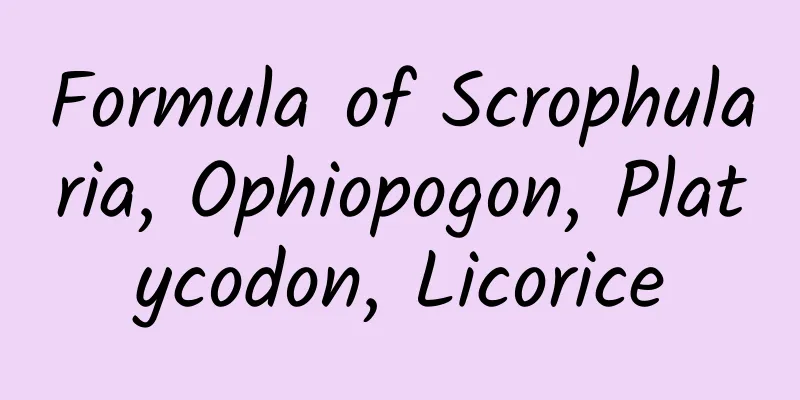Formula of Scrophularia, Ophiopogon, Platycodon, Licorice

|
Scrophularia, Ophiopogon, and Platycodon are three different substances. In fact, these three things are all one of the Chinese herbal medicines. They have certain benefits to the human body, and these three things can be eaten together. However, it has a certain formula. But many people don’t know its specific formula, which leads to the wrong way of eating. So what is the formula of Scrophularia, Ophiopogon, and Platycodon? Scrophularia is used to treat fever and blood stasis, fever, thirst, red tongue, rash, bone steaming and fatigue cough, restlessness and insomnia, fluid damage and constipation, blurred vision, sore throat, scrofula, phlegm nodules, carbuncle and ulcer. Ophiopogon japonicus is a perennial evergreen herb with a relatively thick root, which often swells into an oval or spindle-shaped small root in the middle or near the end. The stem is very short, the leaf base is clustered, grass-like, the bracts are lanceolate, the tip is gradually pointed, and the seeds are spherical. It has the effects of promoting fluid and relieving thirst, moistening the lungs and relieving cough. It is widely cultivated and has a long history. Platycodon grandiflorum is used for cough with sputum and chest tightness due to stagnation of lung qi, sore throat, aphonia, urinary retention and constipation. Licorice tastes sweet and is mild in nature. It enters the heart, spleen, lung and stomach meridians. It is cool when used raw and can purge fire, detoxify, relieve pain. It is warm when roasted and can disperse superficial cold, tonify the middle and replenish qi. In addition, licorice is also good at harmonizing the properties of medicines and detoxifying hundreds of medicines.Effect on blood pressure: When the fluid extract was injected intravenously into anesthetized rabbits, a small amount could slightly increase the blood pressure first and then decrease it; a large amount could only decrease the blood pressure. The water extract, ethanol-water extract, ethanol extract and decoction had a significant antihypertensive effect on anesthetized dogs, cats and rabbits. The antibacterial effect was shown in the test tube. Scrophularia had an inhibitory effect on tinea mentagrophytes, Epidermophyton floccosum and Microspore tinea woolly. The water extract of Scrophularia also had an inhibitory effect on Microspore tinea audouin in the test tube. Experiments have shown that the antibacterial effect of Scrophularia leaves is stronger than that of roots, especially against Staphylococcus aureus. It can be used in combination with liquorice, Ophiopogon japonicus and Platycodon grandiflorum to treat symptoms of febrile diseases such as heat entering the blood, thirst, red tongue, irritability, restless sleep, unclear consciousness or body rashes. |
>>: The efficacy and indications of Cordyceps Ginseng
Recommend
The efficacy and function of night walking
Xingye is a very good medicinal herb. It is often...
#千万IP创科学普# How to charge safely when riding in winter?
Recently, the temperature has been slowly droppin...
Humans cannot marry close relatives, but what about animals?
I recently saw an interesting content: "Why ...
Can having a cold reduce the risk of COVID-19 infection? The truth is not necessarily that simple
Some studies in the past two years have found tha...
When the New Year’s Eve dinner has a “chief commander”, the living room instantly turns into a New Year’s film set. Who makes the New Year atmosphere last longer?
"Xiao X, Xiao X, turn up the volume of Good ...
World Stroke Prevention Day丨Preventable and treatable! Stay away from stroke, here’s what you should know
May 25th of each year is World Stroke Day, which ...
How to drink Niu Dali
Many people don’t know about Niudali, but those w...
What are the benefits of goose not eating grass
In fact, the Russian grass is also a kind of trad...
The efficacy and function of Feilaihe [picture]
There are many types of Chinese medicine. When we...
Don’t blame your husband for having a yellow pillow, he produces half more oil than you!
Audit expert: Zhang Yuhong Chief Physician of Der...
The efficacy and function of hibiscus root
Diseases require improvement through medicine. Di...
What nourishes the stomach and cures stomach problems
Gastric disease is a particularly common disease,...
White porridge and milk are good for the stomach? Don’t believe these 4 stomach-nourishing misunderstandings anymore!
Chinese people know how to eat and are even bette...
The efficacy and function of willow branches
Willow can be said to be a very common tree in ou...
Science Museum丨How many alarm clocks are best for waking up?
The holidays are over and summer is quietly appro...









